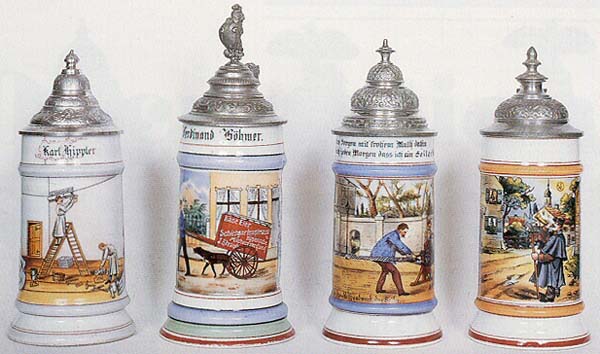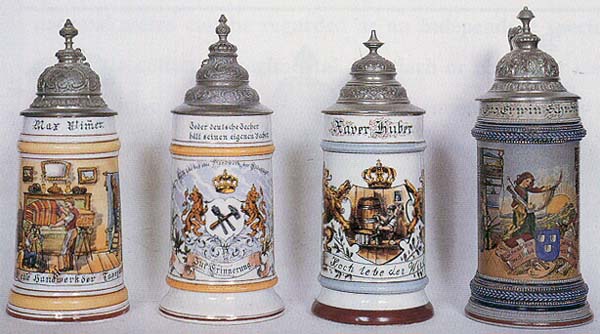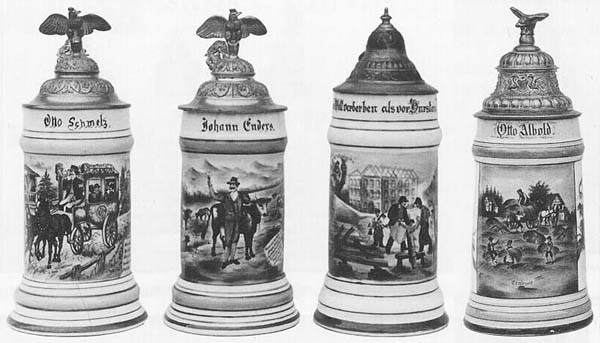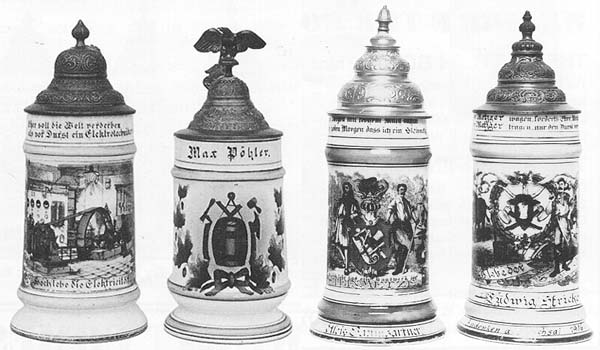 |
by Günter Merk
Translation by Peter Meinlschmidt
Over the years, many beer stein collectors have turned to occupational or trade-related steins as collectibles. Collecting occupational steins can be regarded as an independent specialty, similar to collecting regimental, Mettlach or character steins. Criteria have evolved regarding the assessment of scarcity and value, just as they have with other categories of steins. The first trade-related steins date back to the last decade of the 19th century and their evolution ended abruptly with the outbreak of WWI. Only a few occupational steins bear dates in the 1920s or 1930s. Generally, when dates are found on occupational steins, they indicate time spent in school training for the occupation. These dates usually are between 1895 and 1914.
 |
Steins of this type were primarily made of porcelain, but examples are known to exist in cream stoneware, gray-blue stoneware, and glass. Occupational steins made completely out of pewter are rarely found. The manufacturers and distributors of occupational steins were for the most part located in southern Germany.
The first occupational steins were hand-painted with very simple stein bodies. As the customers eventually demanded better quality products, these simple hand-painted steins were quickly dropped in favor of transfer decorations. This process was generally adopted and, eventually, the only steins for sale were manufactured with steel-engraved transfers. Hand-painted steins were discontinued altogether. The Mettlach steins known as the Occupational Series, numbered 2719 through 2730, were also made to fulfill the demand for steins picturing the occupation of the owner.
 |
Two expressions are usually found on occupational steins. They are: (1) Hoch lebe, followed by the name of the occupation, and (2) Eher soll die Welt verderbeu, als vor Durst ein, followed by the name of the occupation and finally, the word sterben. The presence of either of these expressions enhances the desirability of an occupational stein.
Today, occupational steins are being collected according to the scarcity of the trade and the scenes depicted. The most frequently encountered occupations include farmer (Landwirt), butcher (Metzger), brewer (Bierbrauer), baker (Bäcker) and blacksmith (Schmied). The intermediate range includes cabinetmaker (Schreiner), carpenter (Zimmermann), cheesemaker (Käser or Schweizer) and dairy farmer (Senner). The scarce occupationals include trades such as shepherd (Schafer), gardener (Gartner), shoemaker (Schuhmacher), etc. Subgroups of common trades, such as specialist blacksmith (Hammerschmied) and winegrower (Winzer) are also scarce.
 |
As a general guideline for assessing occupational steins, the following considerations should be taken into account. Occupational steins from trades in which income was formerly good to very good are found more frequently. Trades in which income was low (including miners and fishermen) are rarer, and therefore usually obtain higher sale prices.
The scarcity of the occupational stein is not the only factor determining its value. The pictorial representation of the respective trade is also important. Steins with action pictures command higher prices than those merely adorned with a trade symbol. Along the same lines, beer steins depicting common trades, but adorned with rare and particularly colorful scenes, are also greatly sought after. Finally, quality plays a role with regard to sales price.
 |
Many occupational stein collectors will only purchase drinking vessels with full panoramic scenes, rather than steins with lids having pictures only on the ceramic inset. During the last three years, prices for rare occupational steins have increased considerably and some have even doubled, though common trades have remained fairly stable. Overall, prices for occupationals can be viewed as stable with a tendency toward an upward trend.
__________
*Reprinted from The Beer Stein Journal, February 1995, by permission from Gary Kirsner Auctions.